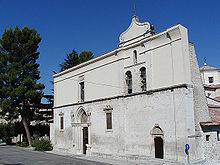Province of L'Aquila | |
|---|---|
 | |
 Map highlighting the location of the province of L'Aquila in Italy | |
| Country | Italy |
| Region | Abruzzo |
| Capital(s) | L'Aquila |
| Comuni | 108 |
| Government | |
| • President | Angelo Caruso (Independent) |
| Area | |
• Total | 5,047.55 km2 (1,948.87 sq mi) |
| Population (30 September 2017) | |
• Total | 300,409 |
| • Density | 60/km2 (150/sq mi) |
| GDP | |
| • Total | €7.286 billion (2015) |
| • Per capita | €23,962 (2015) |
| Time zone | UTC+1 (CET) |
| • Summer (DST) | UTC+2 (CEST) |
| Postal code | 67100, 67010, 67012, 67013, 67014, 67015, 67017, 67019, 67020, 67021, 67022, 67023, 67024, 67025, 67026, 67027, 67028, 67029, 67030, 67031, 67032, 67033, 67034, 67035, 67036, 67037, 67038, 67039, 67040, 67041, 67043, 67044, 67045, 67046, 67047, 67048, 67049, 67050, 67051, 67052, 67053, 67054, 67055, 67056, 67057, 67058, 67059, 67060, 67061, 67062, 67063, 67064, 67066, 67067, 67068, 67069 |
| Telephone prefix | 0862, 0863, 0864 |
| Vehicle registration | AQ |
| ISTAT | 066 |
The province of L'Aquila (Italian : provincia dell'Aquila) is the largest, most mountainous and least densely populated province of the Abruzzo region of Italy. It comprises about half the landmass of Abruzzo and occupies the western part of the region. It has borders with the provinces of Teramo to the north, Pescara and Chieti to the east, Isernia (in Molise region) to the south and Frosinone, Rome and Rieti (in Lazio region) to the west. Its capital is the city of L'Aquila.
Contents
- Economy and population
- Earthquakes
- Main sights
- L' Aquila
- Sulmona
- Rocca Calascio
- Avezzano
- Comuni
- References
- External links
The province of L'Aquila includes the highest mountains of the Apennines (Gran Sasso, Maiella and Velino-Sirente), their highest peak, Corno Grande, the high plain of Campo Imperatore, and Europe's southernmost glacier, the Calderone. The province's major rivers are the Aterno-Pescara, Sangro, Liri, Salto, and the Turano; its major lakes are Lago Scanno and Lago Barrea. It once included the third largest lake on the Italian peninsula, Lago Fucino, which was drained in one of the 19th century's largest engineering projects. The lake basin is today a flourishing agricultural area and an important technological district.










